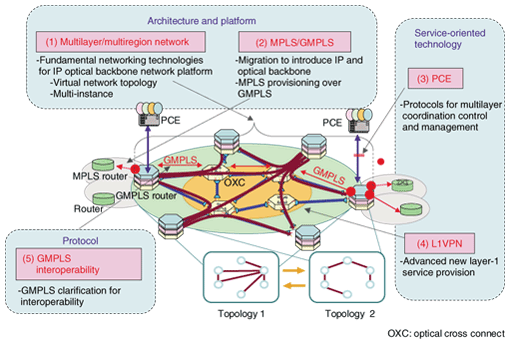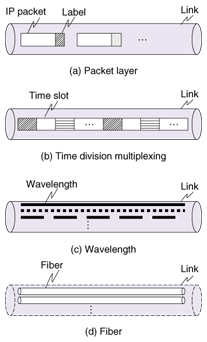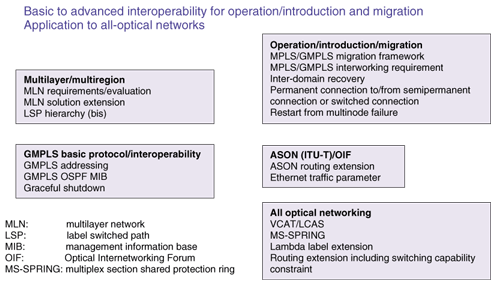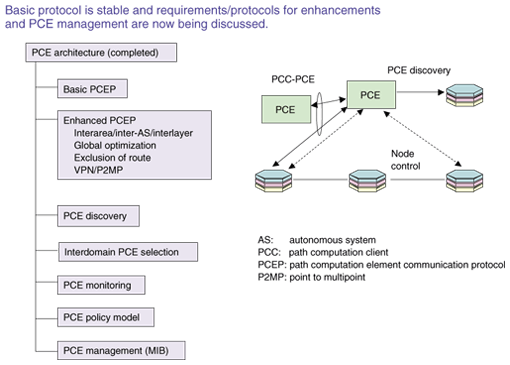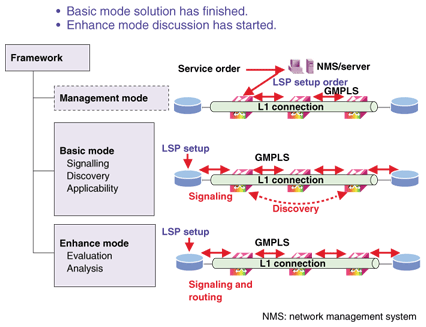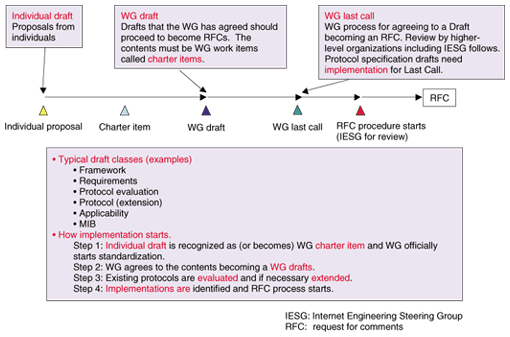 |
|||||||||||
|
|
|||||||||||
|
Global Standardization Activities Vol. 6, No. 4, pp. 28–33, Apr. 2008. https://doi.org/10.53829/ntr200804gls Standardization of IP and Optical Networking TechnologiesAbstractInternet protocol (IP) and optical networking technologies based on generalized multiprotocol label switching (GMPLS), path computation element (PCE), and layer-1 virtual private network (L1VPN) enable unified control and management of future backbone network layers that will be able to cope with unexpected situations such as drastic changes in demand and multiple failures effectively and quickly according to an operator's policy and that will let us create new network services. This article describes the latest standardization of IP and optical networking technologies in IETF (Internet Engineering Task Force) and ITU-T (International Telecommunication Union, Telecommunication Standardization Sector).
1. Importance of IP and optical networking technology standardizationThe backbone networks are currently experiencing great changes, more than ever before, in traffic demand with the wider penetration of broadband access and appearance of unforeseen new applications, but service quality is degraded if there are failures and the impact is heavier than before. Future backbone network should be capable of (1) controlling and managing multiple layers, (2) coping with unexpected situations quickly, (3) applying the operator's policy, (4) providing rate- and format-free flexibility, and (5) providing on-demand services [1]. ITU-T (International Telecommunication Union, Telecommunication Standardization Sector) has been working very hard on NGN (Next Generation Network) standardization to enable various applications over managed packet networks. IETF (Internet Engineering Task Force), on the other hand, has been standardizing Internet protocol (IP) and multiprotocol label switching (MPLS) as de facto technologies, which are now international standard technologies recognized within ITU-T. IETF has been aggressively working on the standardization of IP and optical networking technologies such as generalized multiprotocol label switching (GMPLS), unified optical and IP network architectures (multilayer and multiregional network architectures, and MPLS and GMPLS interworking), flexible and complicated traffic engineering according to operator policy (path computation element (PCE)), and layer-1 virtual private network (L1VPN), which provides protocol-free layer-1 paths on demand. An overview of standardization areas for IP and optical networking technologies is shown in Fig. 1.
2. GMPLS standardizationGMPLS generalizes the label concept of MPLS, which identifies a packet layer data flow, so that the label can be applied to data flows of other layers such as layer-1 connections. Other GMPLS label examples include time slot, wavelength, physical port for fiber, and even packet flow like MPLS labels (see Fig. 2).
The basic set of protocols including extensions of RSVP (resource reservation protocol), OSPF (open shortest path first), and LMP (link management protocol) have been standardized reflecting interoperability test results in the IETF common control and measurement plane (CCAMP) [2] working group (WG). The scope of CCAMP WG is shown in Fig. 3. This WG is mainly discussing GMPLS applications.
The first application of GMPLS is interworking between MPLS and GMPLS and migration from MPLS to GMPLS, where routing and signaling interoperability and migration framework and requirements have now reached the stage of being request for comments (RFC). The second application is GMPLS-based network architectures where requirements and analytical results of existing GMPLS protocols are now stable and expected protocol extensions are being WG draft status. The third application is technology- and implementation-specific aspects including control transition of a path from an operating system provision basis to a GMPLS basis (semipermanent connection to switched connection), protocol extension for Ethernet switching capability, and extensions specific to all-optical networks including reconfigurable optical add/drop multiplexers (ROADMs), which are now being deployed worldwide. IETF and ITU-T have recently been collaborating on GMPLS, where GMPLS applicability to the ITU-T-based transmission network architecture called ASON (automatically switched optical network), and the next generation time-division multiplexing transmission technologies such as LCAS (link capacity adjustment scheme) and VCAT (virtual concatenation). 3. PCE standardizationPCE (path computation element) [3] is a route calculating element that is functionally decoupled from network elements such as routers and switches in which the calculating function was traditionally embedded. The decoupling of the function enables multidomain and multilayer traffic engineering and lowers the burden of calculation scalability and complexity. IETF established the PCE WG based on proposals from NTT and other members in 2005. The basic set of protocols and architectures is stable and nine PCE protocol implementations have been reported, as of December 2007. Current discussion of enhancements includes, firstly, protocol extensions targeting interdomain and interlayer calculation, global optimization where multiple paths are simultaneously optimized, excluding specific nodes, and VPN multicasting. These extensions are expected to be standardized soon after the basic protocol standardization has been finalized around the first half of 2008. The second discussion area includes technologies for PCE to be managed and operated in real networks. Some examples are a PCE discovery protocol, PCE performance monitoring protocol, and new architecture for incorporating network policy into PCE calculations. ITU-T already has an international standard for PCE in the context of ASON, which is G.7715.2. Refer to Fig. 4 for the detailed scope of the PCE WG.
4. L1VPN standardizationL1VPN [4] provides virtually dedicated layer-1 network resources to each customer. It is being standardized in IETF's L1VPN WG, which was established after proposals by NTT and other members in 2005. The framework is already standardized: it defines three L1VPN modes. Protocols related to the basic mode (i.e., signaling and discovery) have passed through the working group level last call. Currently, the most advanced enhanced mode is being worked on through detailed analysis and applicability evaluation of GMPLS protocols for achieving the enhanced mode. ITU-T has already established L1VPN basic international standards based on NTT proposals. Details of the scope of the L1VPN WG are given in Fig. 5.
5. ConclusionIn addition to producing the next-generation network services and technologies, in order to cope with unexpected situations effectively and provide new competitive services quickly, IP and optical networking technologies are expected to play a fundamental role in future telecommunications. IETF and ITU-T have been standardizing GMPLS and other IP and optical networking technologies and NTT has contributed in terms of both technology and management. NTT had contributed 18 major IETF specifications as editor, first author, or coauthors, as of January 2008 (Fig. 6). NTT also provided Japan's second WG chairperson in the area. Recently, other Japanese providers and research institutes have been becoming active and contributing many technical proposals. NTT will continue to contribute to the maturing of technology in both standardization and deployment.
References
|
|||||||||||








